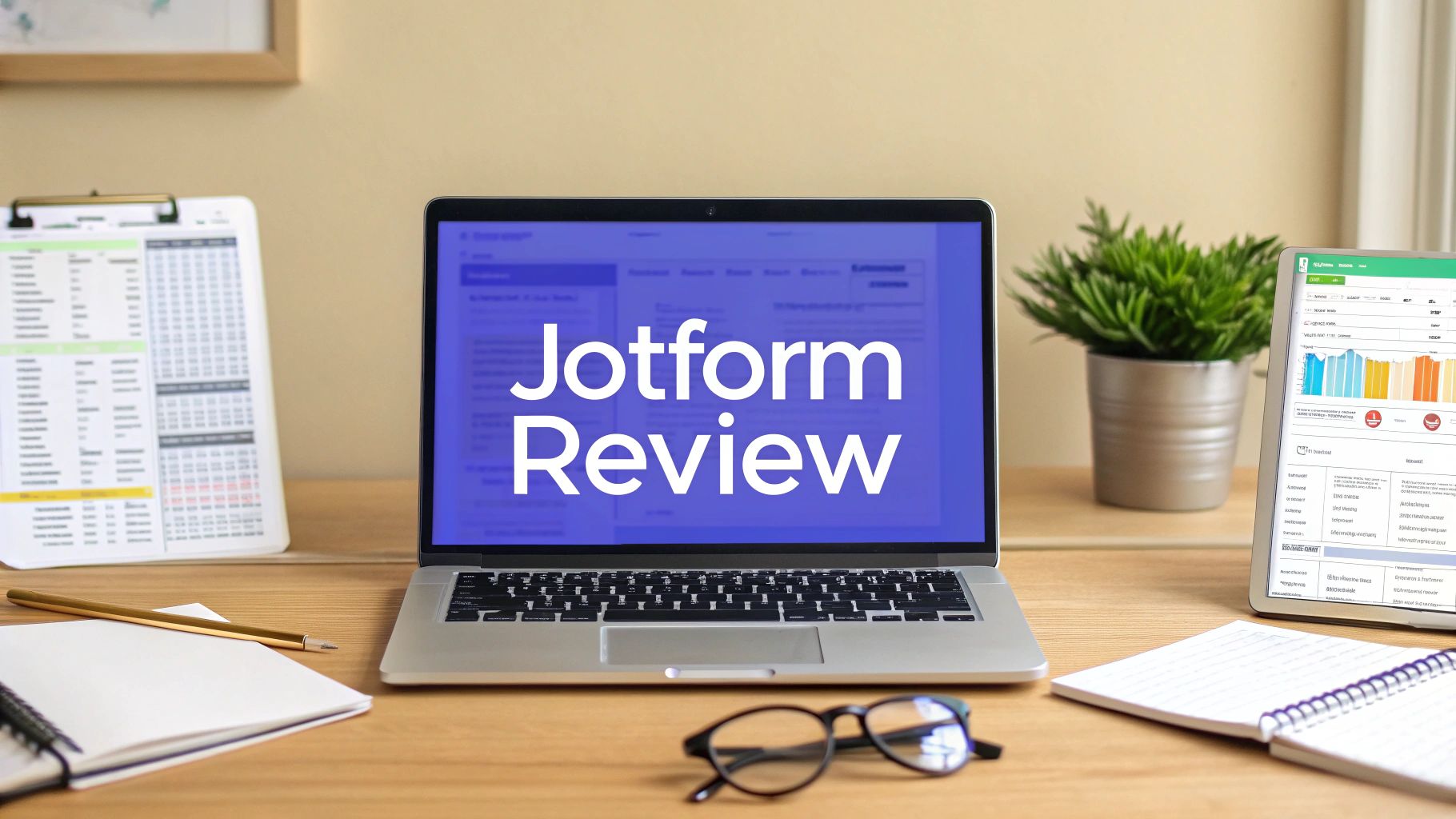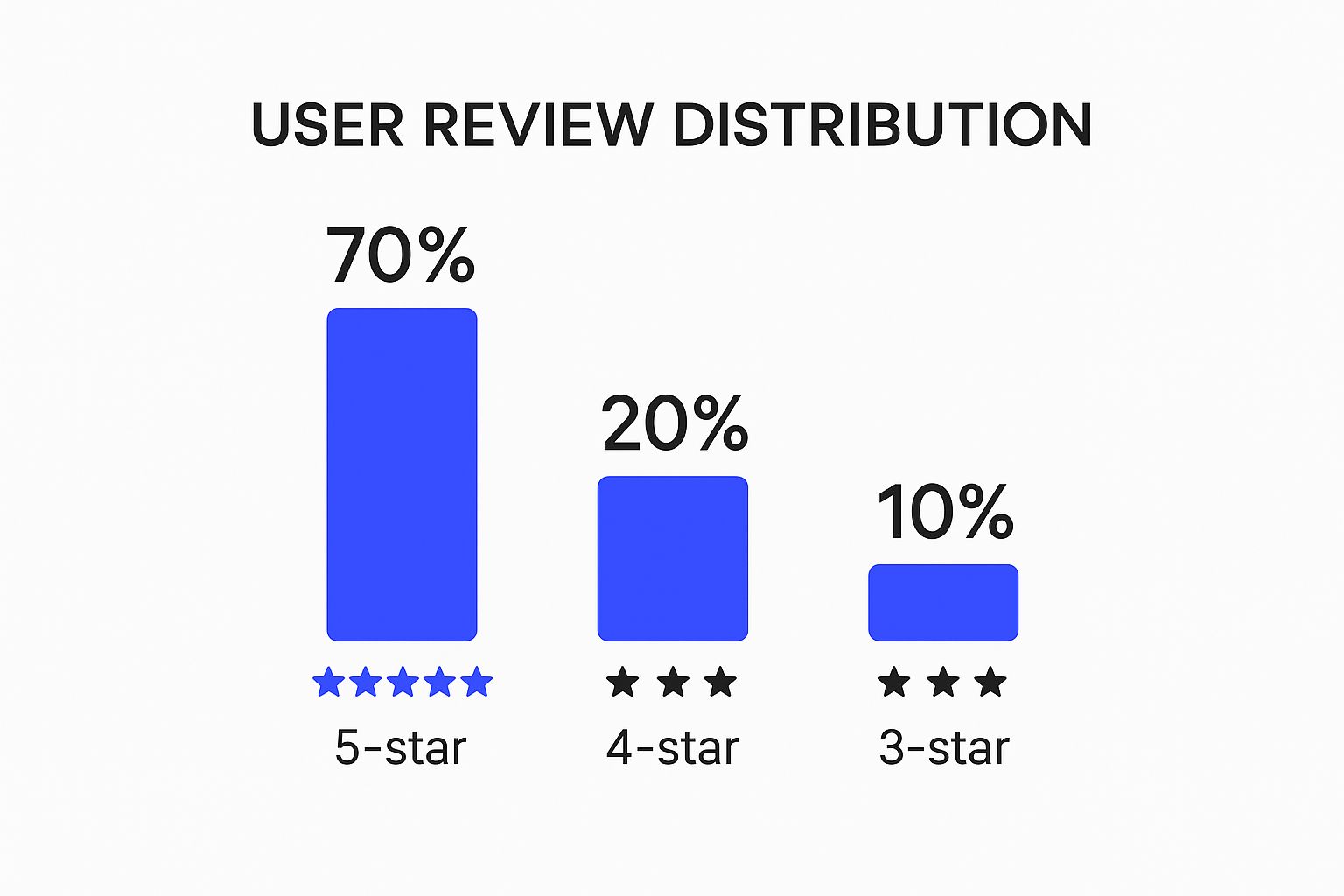Capterra Jotform Review A Deep Dive Comparison
Is Jotform the right tool for you? Our Capterra Jotform review compares it to AI alternatives to help you decide. Get a balanced, in-depth analysis.

When you search on platforms like Capterra for survey and form apps, Jotform comes to mind. It's known for a massive template library and seemingly endless integrations. But for SaaS teams who need to dig deeper into qualitative insights, new types of AI-powered tools like Surva.ai are offering compelling alternatives.
Jotform vs. Surva.ai: A High-Level Comparison
Picking the right data collection tool is a huge decision for any SaaS team. It directly shapes everything from how you capture leads to how you keep customers from churning. The choice usually boils down to two very different philosophies: the feature-packed powerhouse versus the specialized, AI-driven insight engine. Jotform is the former; Surva.ai is the latter.
Jotform has been a dominant force for years. It's the Swiss Army knife of online forms, built to handle just about any data collection task you can throw at it. From simple contact forms to complex event registrations with payment processing, its greatest asset is its sheer breadth of features and customization. If you want to see how it stacks up against other tools, you can also explore our in-depth Capterra review for more on user feedback platforms.
Surva.ai, on the other hand, was built with a much sharper focus: helping SaaS teams truly understand their users with the help of AI. It specializes in conversational forms that feel more like a chat than a rigid survey, which encourages people to share more thoughtful, candid feedback. The goal isn't just to collect data, but to automatically analyze it for trends and sentiment, giving you actionable insights without hours of manual work.
Core Differences at a Glance
The main distinction is pretty clear. Jotform is the go-to if your team needs a reliable, do-it-all workhorse for a wide range of operational tasks and has the internal resources to sift through the data you collect. It’s a proven tool for getting things done efficiently.
Surva.ai is designed specifically for product, marketing, and customer success teams who are obsessed with understanding the "why" behind what users do. It's for those who need to quickly make sense of qualitative feedback to build better product roadmaps, slash churn rates, and nail the customer experience. This is especially relevant when you consider that many of Jotform's nearly 70,000 company users, as noted by enlyft.com, are smaller businesses that just need its straightforward utility.
Key Takeaway: Your choice really hinges on your primary goal. Pick Jotform for operational versatility and building structured, traditional forms. Go with Surva.ai when your mission is to uncover deep user insights with the power of AI.
To make things even clearer, let's break down the key differences between these two platforms.
Jotform vs. Surva.ai At a Glance
The table below offers a quick, side-by-side look at what defines each tool, helping you see where their strengths align with your needs.
AttributeJotformSurva.aiPrimary Use CaseBuilding a wide range of traditional online forms (payments, registrations, surveys).Collecting and analyzing qualitative user feedback with AI.Best ForTeams needing a versatile, all-purpose form builder with massive integration options.SaaS product, CX, and marketing teams focused on user insights.Key StrengthExtensive template library, advanced conditional logic, and broad integrations.AI-powered analytics, conversational forms, and automated insights.Data AnalysisProvides robust tools for manual data reporting and visualization.Automatically analyzes qualitative data for sentiment and key themes.
Ultimately, Jotform gives you the tools to build almost anything, while Surva.ai gives you the AI-driven intelligence to understand what your users are really telling you.
Comparing Form Building and Customization Features

The heart of any form tool is its builder—it’s where the magic happens and where your creative freedom either flourishes or gets stifled. A quick glance through the Capterra Jotform reviews shows a consistent theme: users love its powerful, traditional form-building experience. Surva.ai, on the other hand, comes at form creation from a completely different, AI-first angle.
Jotform’s biggest strength is its mature, drag-and-drop editor. Think of it as a workhorse built for meticulous control. You can place fields with precision, tweak spacing down to the pixel, and customize every visual element to perfection. This is a dream come true for teams that need to create pixel-perfect forms that align with strict branding guidelines or involve complex layouts.
Jotform's Classic Control vs. Surva.ai's AI Speed
With Jotform, you get an enormous library of field types. You can build with everything from basic text fields and multiple-choice questions to more advanced elements like file uploads, payment gateways, and even integrated appointment schedulers. This massive toolkit makes it a go-to for a huge range of operational needs, from event registrations to internal order processing.
Surva.ai throws out the manual playbook and instead prioritizes speed and user experience through AI. Instead of dragging and dropping fields, you simply tell the AI what you need—for example, "Create a survey to get feedback on our new onboarding process." The platform then generates a conversational form that feels more like a natural chat, which can seriously boost completion rates and encourage more honest, detailed responses.
This difference in approach is really the core of it all:
- Jotform: You’re the architect. You have total control over every single detail.
- Surva.ai: The AI is your assistant, instantly building a solid foundation that you can then fine-tune.
Key Insight: Jotform's value is in its deep customization and control, making it perfect for complex, multi-page forms. Surva.ai's strength lies in its AI-driven speed and conversational style, which is ideal for quickly launching engaging feedback surveys.
Diving into Templates and Conditional Logic
One of the biggest advantages you’ll see mentioned in Capterra Jotform discussions is its absolutely massive template library. With a user base of over 20 million people worldwide, Jotform boasts a collection of more than 10,000 ready-made templates and hundreds of integrations. This huge repository, which you can read more about on Theirstack.com, means you almost never have to start from scratch—a massive time-saver for any team.
Jotform also shines with its advanced conditional logic. You can build intricate rules to show or hide fields, skip entire pages, or even run calculations based on a user's previous answers. This is perfect for creating dynamic registration forms, detailed qualification quizzes, or sophisticated order forms with variable pricing.
Surva.ai handles this with dynamic question branching, which is inherently conversational. Instead of just showing or hiding static fields, the AI can adapt the flow of questions based on the sentiment and content of a user's answers, creating a truly interactive and personalized experience.
Here’s a quick look at how their logic stacks up:
FeatureJotform's ApproachSurva.ai's ApproachLogic TypeRule-based conditional logicAI-powered dynamic branchingUser ExperienceA structured, multi-step pathA fluid, conversational flowBest ForComplex applications and payment forms with fixed paths.Qualitative feedback surveys that need to adapt to user input.SetupManual rule creation ("if this, then that").Often automated by AI based on the survey's goals.
So, if your SaaS team is building a detailed onboarding checklist, Jotform’s granular conditional logic is a clear winner. But if your product team is trying to figure out why users are abandoning a new feature, Surva.ai’s conversational and adaptive questioning will likely pull out more authentic and insightful feedback. It all comes down to whether your goal is structured data collection or deep user understanding.
Evaluating Data Collection and Analytics Capabilities

Collecting data is only half the battle; the real value comes from what you do with it. This is where the analytics and reporting philosophies of Jotform and Surva.ai diverge most sharply. Your choice here depends entirely on whether your team prefers to manually dig for insights or receive them automatically.
If you scroll through Capterra Jotform reviews, a common theme you'll see is the platform's reliability as a data repository. It's fantastic at collecting structured information and giving you the tools to organize it. Jotform provides a solid foundation for teams that have the time and expertise to perform their own analysis.
In contrast, Surva.ai is built to be an active participant in your analysis process. It doesn't just store data; it interprets it for you, transforming raw feedback into actionable intelligence from the moment it’s collected. This is especially powerful for SaaS teams needing to quickly understand qualitative user feedback without spending days on manual work.
Jotform’s Approach: Hands-On Reporting and Analysis
Jotform’s analytics suite is all about giving you clarity and control. Its standout feature is the Report Builder, a tool that lets you transform raw submission data into professional, easy-to-read visual reports. You can spin up charts, graphs, and tables to track submission trends, visualize survey responses, and present key metrics to stakeholders without much fuss.
The platform puts you in the driver's seat of your data. You can:
- Generate visual reports: Turn form submissions into bar graphs, pie charts, and other visualizations to spot trends over time.
- Create data grids: View submissions in a spreadsheet-like format within Jotform Tables, where you can sort, filter, and manage data.
- Export data flexibly: Easily pull submissions into Excel, CSV, or PDF formats, allowing you to import data into more advanced BI tools like Tableau or Power BI for deeper analysis.
This approach is perfect for teams that already have established data analysis workflows and just need a reliable source of structured data. A marketing team, for instance, could use Jotform to collect lead data and then export it to their CRM for lead scoring and campaign attribution analysis. The responsibility for finding the insights rests entirely with the user.
Surva.ai’s Approach: AI-Driven Insight Generation
Surva.ai flips the script by putting AI at the core of its analytics. Its primary goal is to slash the manual work required to understand qualitative, open-ended feedback—a task that can eat up hundreds of hours for product and CX teams. Instead of just showing you the raw data, Surva.ai actively analyzes it for you.
Its AI engine automatically handles several critical tasks:
- Sentiment Analysis: Every open-ended response is automatically scored for positive, negative, or neutral sentiment, giving you an immediate pulse on user feelings.
- Thematic Grouping: The AI identifies and groups recurring themes and topics from unstructured text, so you can see what users are consistently talking about without reading every single response.
- Trend Identification: It surfaces emerging trends in feedback, helping you spot potential issues or opportunities before they become widespread.
The fundamental difference is this: Jotform gives you a comprehensive dataset and the tools to build your own reports. Surva.ai processes that dataset for you, delivering pre-analyzed insights that guide you directly to the most critical user feedback.
Imagine you've received 500 responses to a cancellation survey. With Jotform, you'd export the data to a spreadsheet and start manually tagging reasons. With Surva.ai, your dashboard would instantly show that 35% of cancellations mention "missing feature X" with highly negative sentiment, allowing your product team to react immediately. This is the core value of AI-powered analytics in a nutshell.
Analyzing Integrations and Workflow Automation
A form builder's real power isn't just in the questions it asks, but in how well it plugs into the tools your team already lives in every day. This is where you find out if it’s going to be a central hub for your workflows or just another island of data you have to swim to. When you're looking at a Capterra Jotform review, its integration ecosystem is a huge piece of the puzzle, especially when stacked against a tool like Surva.ai.
Jotform’s Broad Integration Library
Jotform's main selling point here is sheer volume. With a library of over 200 pre-built connections, it’s built for plug-and-play simplicity. This isn't just a handful of big names; the selection covers just about every business function you can think of.
You can easily hook your forms up to:
- Payment Gateways: Instantly take payments through Stripe, PayPal, Square, and tons of others right from your forms.
- CRMs: Zap lead data from a contact form straight into Salesforce, HubSpot, or Zoho CRM, killing manual data entry.
- Marketing Automation: Add new subscribers to your Mailchimp or Constant Contact lists the second they sign up.
- Cloud Storage: Automatically save file uploads from applications or feedback forms directly to Google Drive, Dropbox, or Box.
This is perfect for teams that need to automate common business processes without bugging a developer. For example, a marketing team can spin up an event registration form that takes payments via Stripe, adds the attendee to a HubSpot workflow, and pipes their info into a Google Sheet for the event planners—all set up in a few minutes. When looking at form builders, it’s also helpful to see how other top-tier tools handle this, for instance, by exploring options for integrating other survey tools like Typeform.
Surva.ai’s API-First and Modern Stack Focus
Surva.ai, on the other hand, takes a more targeted, developer-friendly approach. While it has key native integrations with tools like Slack, it’s an API-first platform at its core. This means it was engineered from the ground up for deep, custom connections within a modern SaaS stack.
Instead of a sprawling library of surface-level connections, Surva.ai is all about real-time data flow through its powerful API and integrations with data hubs like Segment. This lets SaaS teams pipe rich, qualitative feedback directly into their most critical systems.
Key Difference: Jotform gives you a massive toolbox of pre-built integrations for immediate, broad operational wins. Surva.ai gives you a powerful, flexible API for deep, custom workflows that are tailored to a modern, data-driven tech stack.
For a product team, this is a completely different ballgame. Imagine a user leaves negative feedback in a Surva.ai survey. A custom workflow could fire off several actions at once: create a high-priority ticket in Jira, shoot a notification with the raw feedback to a dedicated Slack channel, and update that customer’s health score in your internal dashboard. This is where Surva.ai's API-first philosophy really flexes its muscles.
Situational Recommendations for Your Team
So, which one is right for you? It really boils down to your team's technical skills and what you're trying to accomplish.
Integration ScenarioRecommended PlatformWhy It FitsBroad Business AutomationJotformIts massive library of native, no-code integrations is perfect for automating standard tasks across marketing, sales, and HR without tying up developer resources.Deep Product WorkflowsSurva.aiThe robust API is built for engineering and product teams who need to send real-time qualitative data into custom dashboards, data warehouses, or BI tools.Payment & Registration FormsJotformWith dozens of direct payment gateway integrations, it’s the clear winner for processing transactions and managing complex event registrations out of the box.Real-Time Insight AlertingSurva.aiThe power to trigger custom alerts in Slack or create tickets in Jira based on feedback makes it far better for proactive customer success and product teams.
Jotform’s wide-reaching integration capabilities are a reflection of its massive market adoption. Its customer base is heavily concentrated in the United States, with over 73% of its users located there, followed by the UK and Canada. You can dig deeper into its market share and presence by checking out the insights on Jotform's market distribution on 6sense.com. This strong foothold in North America and Europe shows its appeal in markets where broad digital integration is a standard part of doing business.
Deconstructing Pricing and Overall Value
When you're trying to choose a new tool, it’s not just about the features—it's about the return on your investment. The pricing for Jotform and Surva.ai really shows what each platform is all about. One is built for volume and features, while the other is all about intelligence and impact. Getting a handle on these different approaches is key to picking the right one for your team.
Jotform sticks to a pretty traditional tiered subscription model that scales up with your usage. You've got a solid free plan, which is great for getting started, followed by Bronze, Silver, and Gold plans. As you move up, you get higher limits on things like how many forms you can have, monthly submissions, and storage space. It’s a straightforward and predictable model, perfect for teams who can guesstimate their usage and need to stick to a clear budget.
Surva.ai, on the other hand, structures its pricing around the value of the insights it delivers. Its model is often tied to how much AI-powered analysis you're doing or the number of feedback responses it processes. This aligns the cost directly with the platform's biggest selling point: turning raw feedback into smart, strategic decisions.
Comparing Value at Similar Price Tiers
When you start comparing plans at similar price points, you really see where the value proposition for each tool shines.
A top-tier Jotform plan gives you the power to handle a massive number of submissions, which is a must-have for big operations like major event registrations or large-scale lead gen campaigns. But put that same money into a Surva.ai plan, and you get access to powerful AI analytics that can save your team hundreds of hours of manual data crunching.
To really see what I mean, just look at how users feel about these kinds of tools. This chart gives you a glimpse into the general sentiment in the space.

That high percentage of 5-star ratings tells a story: when users find the right tool for their specific job, they are overwhelmingly happy with the value they get. Keep this in mind as you dig through reviews and try to make your choice.
To help you visualize the trade-offs, here's a direct comparison of what you get for a similar investment in both platforms.
Feature or LimitJotform (Gold Plan)Surva.ai (Pro Plan)Price$99/month$99/monthSubmissions10,000/month1,000/monthUsers55Form/Survey Limit100UnlimitedAI AnalysisNot availableIncluded (1,000 responses)Best ForHigh-volume data collectionIn-depth feedback analysisPrimary ValueOperational scaleStrategic insights
As you can see, the decision isn't about which one is "better" in a vacuum. It's about what your team needs to accomplish right now. Do you need to process a flood of entries, or do you need to understand the why behind a smaller, more focused set of responses?
The True Calculation of ROI
Let's be real, the true return on investment isn't just what you pay each month. Thinking about different software pricing strategies can help frame the value conversation.
With Jotform, the ROI is all about operational efficiency. How many hours did you save by automating workflows? How many leads did you capture without someone having to lift a finger? A review might point out how the HIPAA-compliant features on the $99/month Gold plan deliver massive value for a healthcare company by securing sensitive data at scale.
For Surva.ai, the ROI is measured by strategic impact. It’s about how fast your team can spot a major churn risk, validate a new product idea, or understand the sentiment driving customer feedback. This kind of value is a bit harder to put a number on, but it can be game-changing. For a deeper dive on how users weigh these factors, you can find a full breakdown in our https://www.surva.ai/blog/capterra-review.
The bottom line is this: Jotform’s value lies in volume and operational scale—doing more things for a predictable cost. Surva.ai’s value is in intelligence and strategic speed—making smarter decisions, faster. Your team needs to be honest about which type of ROI is more critical for hitting your goals right now.
Which Tool Is Right For Your Team?

Choosing between Jotform and Surva.ai isn't about finding a single “best” tool. It’s about figuring out which one is the right fit for the job your team needs to do.
The decision really boils down to one simple question: Is your primary goal operational scale or strategic insight? Answering that honestly will point you straight to the platform that delivers the most value for your specific needs.
A quick look at Capterra Jotform reviews shows a tool that’s loved for its sheer power and versatility. It’s the undisputed champion for teams that need to build and deploy a high volume of forms for all sorts of business functions. Think of it as the ultimate operational workhorse.
When to Choose Jotform
Jotform is the clear winner if your team’s success hinges on building structured, process-driven forms at scale. It’s designed for situations where the main goal is to collect standardized data efficiently and reliably.
You should go with Jotform if your team needs to:
- Build complex registration or payment forms: Its massive library of payment integrations and advanced conditional logic make it perfect for handling event sign-ups, online orders, or detailed application processes.
- Automate a wide variety of business tasks: With over 100 integrations, it connects smoothly to the tools your entire organization already uses, from CRMs to cloud storage, without needing a developer to step in.
- Create a high volume of traditional forms: If your marketing, HR, and operations teams all need different forms for their day-to-day work, Jotform’s huge template library and user-friendly builder are a lifesaver.
Ideal User Profile for Jotform: An operations or marketing team that needs a powerful, all-in-one form builder to automate and scale tons of data collection tasks, from lead capture to payment processing, without needing deep data analysis inside the tool itself.
When to Choose Surva.ai
Surva.ai, on the other hand, was built to solve a completely different problem. It’s for teams that aren’t just collecting data but are on a mission to understand the human story behind it. The platform’s real strength is its ability to pull meaningful insights from qualitative feedback with very little manual work.
For a closer look at how it stacks up against other conversational tools, check out our analysis of Typeform on Capterra.
This tool is the best choice for product, customer success, and marketing teams focused on gathering deep, unstructured feedback. It really shines in scenarios where understanding user sentiment and motivation is more important than just collecting data points.
Ideal User Profile for Surva.ai: A product or customer experience team at a SaaS company focused on understanding the "why" behind user behavior. They need to quickly analyze qualitative feedback from conversational surveys to reduce churn, improve product-market fit, and make data-driven roadmap decisions.
Ultimately, the right choice becomes obvious once you define your core objective. If you need to build the functional backbone of your business processes, Jotform is a reliable powerhouse. But if you need to uncover the critical user insights that drive growth and retention, Surva.ai offers a focused, intelligent solution.
Frequently Asked Questions
Even after a side-by-side comparison, a few questions might still be lingering. We get it. This section dives into the common queries that pop up, especially in Capterra Jotform reviews and user forums, to help you nail down your final decision.
How Reliable Are Capterra Reviews For Jotform?
Capterra is a solid source for software reviews. Because it pulls from a massive pool of verified users, you get a much more balanced view of how a tool actually performs in the wild, not just how it looks in a demo.
When you're digging through Capterra Jotform reviews, the trick is to look for patterns that match your own situation. Keep an eye out for comments on customer support, how well it plays with the tools you already use, and if it's easy to use for tasks similar to yours. This helps you tune out the noise and focus on what matters to your team.
Can Jotform Handle Complex Conditional Logic?
Absolutely. This is where Jotform really shines. It has a powerful conditional logic engine that's built for creating complex, multi-step processes like detailed SaaS onboarding flows or dynamic application forms.
You can easily set up rules to:
- Show or hide fields based on what a user answers.
- Skip entire pages to create a personalized path through the form.
- Run calculations on the fly for things like quotes or order forms.
This is a huge step up from simpler builders and a key reason it holds a high 4.7 out of 5-star rating on sites like Capterra. If you need to guide users through a specific, structured journey without overwhelming them, Jotform's advanced logic is a major plus.
Key Insight: Jotform's strength in conditional logic makes it ideal for structured, rule-based processes. It gives you the control to build sophisticated forms that adapt to user input in predictable, clearly defined ways.
Is Surva.ai Better For Qualitative Product Feedback?
For rich, qualitative product feedback, Surva.ai is almost always the better pick. It comes down to its conversational style and, more importantly, its AI-powered analysis.
The chat-like survey format naturally encourages people to give more detailed, open-ended answers than they would in a traditional form. But the real magic is what happens next: Surva.ai's AI automatically digs through all that unstructured text to find sentiment, key themes, and actionable insights.
This saves product teams from the soul-crushing work of manually sifting through and categorizing feedback. If your goal is to truly understand the why behind user behavior, Surva.ai has a serious edge.
Ready to stop guessing and start understanding your users? Surva.ai gives you the AI-powered tools to turn customer feedback into your biggest growth lever. Start your free trial today and see what insights you can uncover.


